lynne webb
GONE BUT NOT FORGOTTEN
Alberta , I used to go the same route as you to catch my bus, I met Roy Orbison outside the Grand Hotel, he stood talking to us for ages although a taxi was waiting for him..A lovely man.
Just read that the Great Western Arcade originally came to a dead end in Temple Row but in the early 1880s its line was continued as the North Western Arcade right through to Corporation Street. Is that the arcade that goes alongside the House of Fraser? Viv.
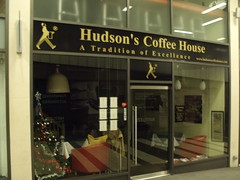
Alberta , I used to go the same route as you to catch my bus, I met Roy Orbison outside the Grand Hotel, he stood talking to us for ages although a taxi was waiting for him..A lovely man.
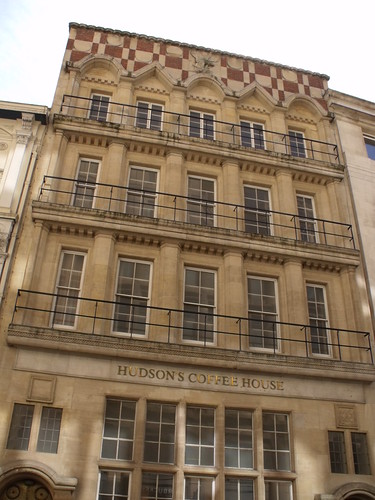
From Pesvner Architectural Guides: Birmingham by Andy FosterNos. 122-124 are the former Eagle Insurance offices, by W.R. Lethaby & J.L. Ball, 1900. One of the most important monuments of the Arts and Crafts Free Style in the country. The design is essentially Lethaby's; Ball was the executant. Pevsner saw it as an early example of functionalism.
Recent research has emphasized Lethaby's interest in symbolism and primitive forms, described in his Architecture, Mysticism and Myth (1892). most obvious here in the eagle, symbolizing the sun god. The structure of loa-bearing walls, concrete floors, and steel joists is expressed directly and simply in the facade. Ground floor banking hall lit by a large mullion-and-transom window carried down to the ground. The doorways have segmental hoods and three-part mouldings deriving from Buddhist temples. Glowing bronze doors with moulded discs representing the sun. Above, three floors of offices with a grid of chamfered pilasters between chunky cornices again with three-part mouldings. Over the top floor a dramatic motif of alternating round- and triangular-headed arches.
Godfrey Rubens suggests a re-working of the basic round and pointed architectural shapes Ruskin identified in The Nature of Gothic; Alexandra Wedgwood noticed the primitive, Anglo-Saxon appearance of the triangular heads. Finally a parapet of two layers with a chequer design of alternating wide and narrow brick and stone panels, with more sun discs and an eagle relief in the centre.
From 122 AND 124, COLMORE ROW B3 on Heritage Gateway1900, by Lethaby and Ball for the Eagle Insurance Company. Stone with a little brick. Four storeys; 5 bays. Ground floor with a large 5-light mullioned and transomed window and symmetrical doorways left and right with simple 2-light windows and sculptured plaques above. First, second and third floors each with uniform sash windows between pilasters. The 3rd floor windows with a frieze of Romansque derivation in their heads and alternating semi-circular and triangular pediments above. Attic storey with chequer work pattern in which are set plain blank discs and, centrally, an eagle. Original metal doors and much of the interior furnishings and fittings remain.

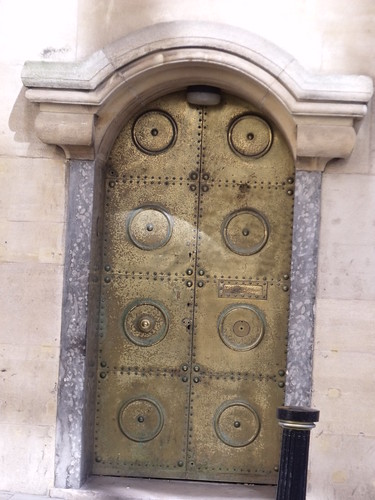
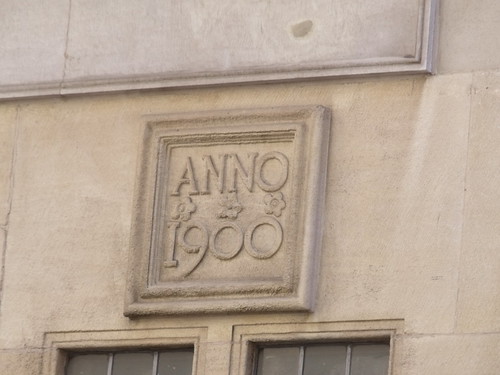
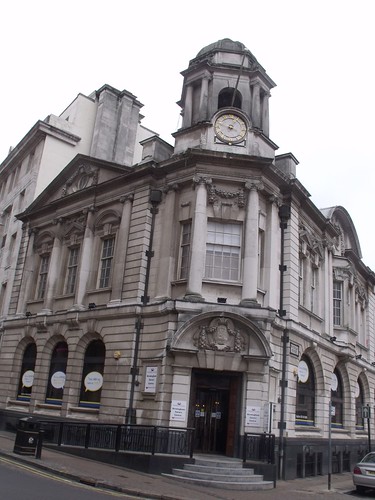
No. 130 by Goddard & Co. of Leicester, 1903, for the Alliance Assurance. Two ample storeys in Wrenaissance style. Good domed corner turret, and a canted bay to Waterloo Street. Juicy garlands.
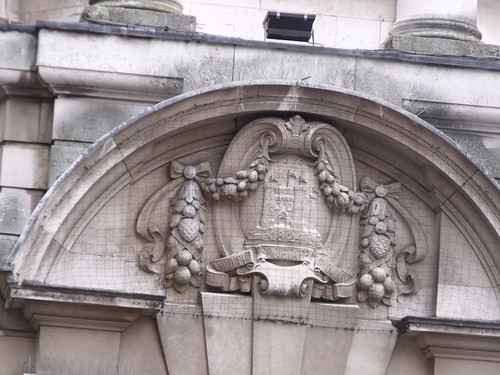
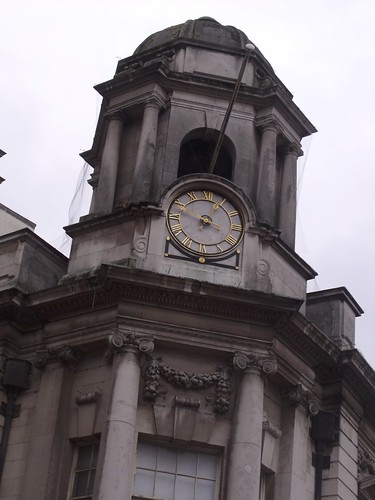
- Grade I: buildings "of exceptional interest, sometimes considered to be internationally important".
- Grade II*: "particularly important buildings of more than special interest".
- Grade II: buildings that are "nationally important and of special interest".
Government general policy is to list all buildings erected before 1700 "which survive in anything like their original condition" and most buildings of 1700–1840. More selection is exercised among buildings of the Victorian period and the 20th century. Buildings less than 30 years old are rarely listed, and buildings less than 10 years old never.


Nos. 114-116 is a full blown Barosque weddingcake of 1912 by Paul Waterhouse, for the Atlas Assurance. A big portico is hoist aloft above much rustication, circular windows, garlands and all the panoply of commerce. An extreme contrast to Lethaby: pure scene-painting with regular office floors behind, but very effective. The facadism is expressed by Mannerist detail: the large lunette window on the ground floor directly below the portico, and the two small, heavily blocked windows immediately under the pilasters.
COLMORE ROW
1.
5104
City Centre B3
Nos 114 and 116
(Standard House)
SP 0686 NE 33/17 13.11.81
II GV
2.
Early C20, in an Edwardian Baroque style. Stone. Two storeys plus another 2 plus
attic represented by a giant portico standing on the segmental pediments of 2
windows with heavy Gibbsian surrounds, and recessed outer bays. The ground floor
with a large central arched opening with immense keystone set in banded rustication
and 2 entrances, each with a circular window with garlands and a heavy balcony above.
Listing NGR: SP0679586940
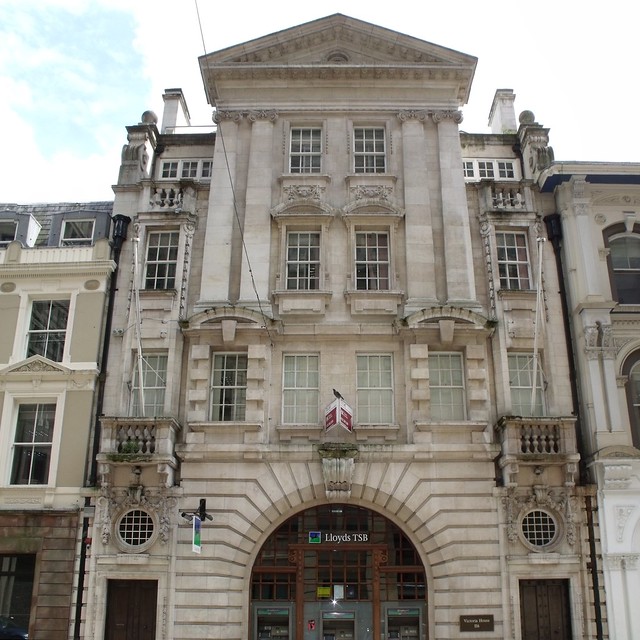
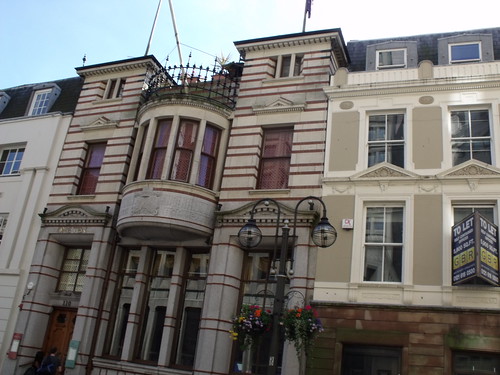
No. 110 is a picturesque and original piece of 1903-4 by Henman & Cooper for the Scottish Union and National Insurance Co. Aberdeen granite, appropriately, and limestone, with inset bands of red brick. Two-storey centre with big semicircular oriel and fine original railing, clamped between three-storey towers with tapering tops, ogee caps and tall finials.
COLMORE ROW
1.
5104
City Centre B3
No 110
SP 0686 NE 33/15
II GV
2.
1902, by William Henman and Thomas Cooper. Granite with irregularly spaced red
jointing bands. Facade and plan are alike complicated. Three bays, the outer ones
like square turrets with battered sides, bobbin-like finials at the corners and
shallow domes sprouting flag-staffs, the centre one with a large ground floor
tripartite window and a 1st floor bow window welling out from the facade and carrying
a spiky iron railing. The turrets each have a tall ground noon frame with battered
sides and dentilled undulating pediments. In the frames, on the left, the entrance
with window above and, on the right, a tall window. Above these, each turret has a
simple sash window with detached pedimented cornice and a window set within deeply
splayed reveals and behind 'mullions'. The plan with, towards the back, an almost
completely circular shape to the left and an octagonal shape to the right.
Listing NGR: SP0680686954
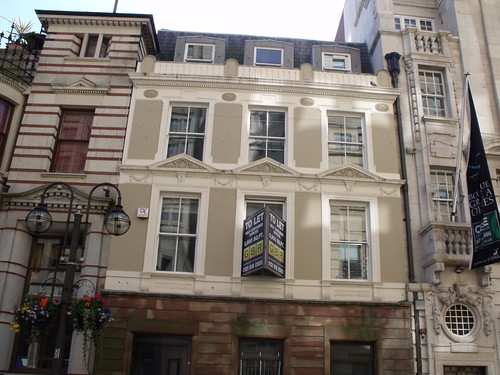
No. 112 of c. 1823 has a crisp stucco front with delicate detail: pediments with anthemion decoration, garlands, and oval discs. Stepped-up lugged architraves.
1. COLMORE ROW
5104 City Centre B3
SP 0686 NE 33/16 No 112
II
2.
Early C19, altered. Painted stucco. 3 storeys plus modern attic; 3 bays. Ground
floor with a modern shop front. 1st and 2nd floors each with 3 sash windows later
given frames, those ofthe 1st floor with pediments that project into the 2nd floor
region. An apparent altered parapet.
Listing NGR: SP0679886952

Nos. 118-120 is entertaining but mongrel stucco Italianate of c. 1875.
COLMORE ROW
1.
5104
City Centre B3
Nos 118 and 120
SP 0686 NE 33/18
II GV
2.
Late C19. Stucco. Three storeys; 6 bays, the outer 2 broader and slightly advanced.
Ground floor with arched entrances with flanking coupled pilasters and, centrally,
4 segment-headed windows. First and second floors with arched window except those
of the 2nd floor outer bays. Coarse detailing and listed for group value only.
Listing NGR: SP0678286932
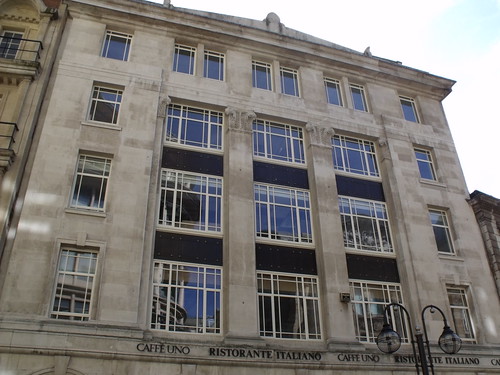

No. 126 of 1926 by S.N. Cooke for the North British and Mercantile Insurance. Cleanly articulated, with giant Ionic pilasters.

